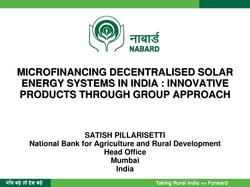Click here to register!
Microfinancing Decentralized Solar Energy Systems in India: Innovative Products through Group Approach
From energypedia
Revision as of 14:43, 8 May 2014 by ***** (***** | *****)
Microfinancing Decentralized Solar Energy Systems in India: Innovative Products through Group Approach
Presenter: Satish Pillarisetti, (National Bank for Agriculture and Rural Development, India)
Rapporteur: Austin Cappon
Overview
| The apex development bank in India-NABARD (National Bank for Agriculture and Rural Development) first facilitated the microfinancing scheme for solar home lighting system by rural banks. This turned out to be a success and the government introduced a subsidy linked bank credit programme to upscale and mainstream the programme. Initially the programme met with only a limited success as it had too many loose ends. Later, with a number of modifications, the programme gradually took off and is now making steady progress. However, NABARD realized that there are many areas and communities which may not be able to benefit by this scheme and may need a different financial product. NABARD developed group based products for such communities. These products are based on a partnership with NGOs, and at times involving retail banks. The successful take off of two such products is discussed here[1]. |
Issues Presented
► Please see the presentation.
- Financing rural home lighting
- This has been facilitated by a change in the govt approach to finacning,
- Case Study: Girls Hostels
- Many islands lack grid connectivity
- Rather rely on gas lamps
- Solar Led was the propoesd solution
- Needed financing 30% as loan and 50% grant.
- Rather rely on gas lamps
- Remaing balance was split (see slide 5)
- RIF = Rural Innovation Fund
- Case study: Charging stations
- 40 charging stations wuld be set up and 2000 families covered in total
- Only 250 families came to be covered in total
- They didn’t like LEDs but rather CFLs
- So the govt came to contact Nabard (Satish’s Group) and they had to change their approach
- 93% of stations are functional
- Case study: Charging stations
- Loans serviced regularlly, no issues with repayment
- Effective Community Participation Needed
- “People are ready for group financinal projects, but not physical projects”
- Loan Portion of all cases is at market values (15%) which is not subsidized
- More Field evaluation is needed
Q & A
1. Big and small micro finance: How to motivate each:
- Local field level organizations are the “superman” or group that was capable of motivating
2. How far can you get to that 1.3 Billion number with subsidized funding offers
- In the case with 10% grants, the govt. seems to be willing to pay if it provides ample utility to the poorest of the poor. Interested in the social building.
References
- ↑ Microfinancing decentralized solar energy systems in India: Innovative products through group approach.Satish Pillarisetti.





















